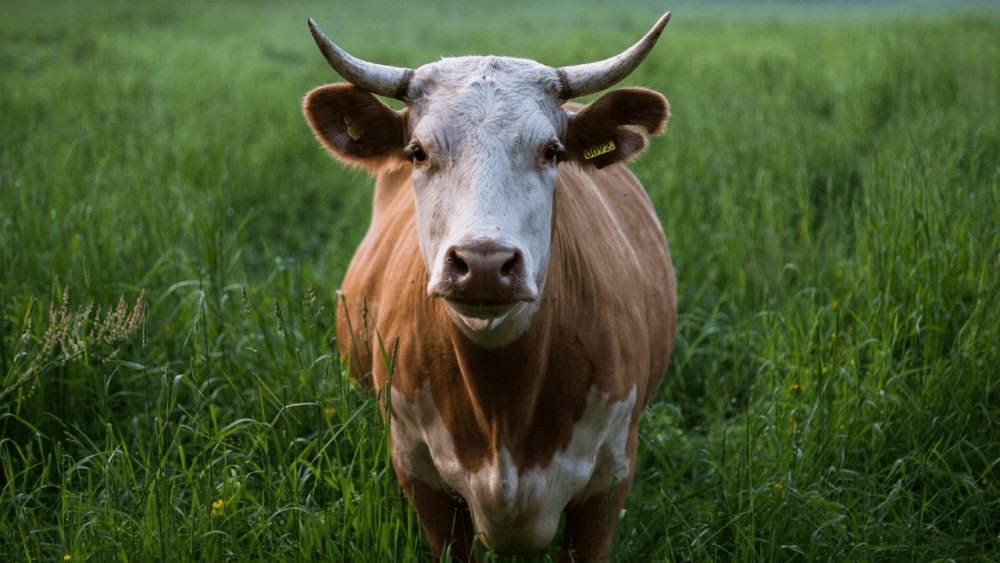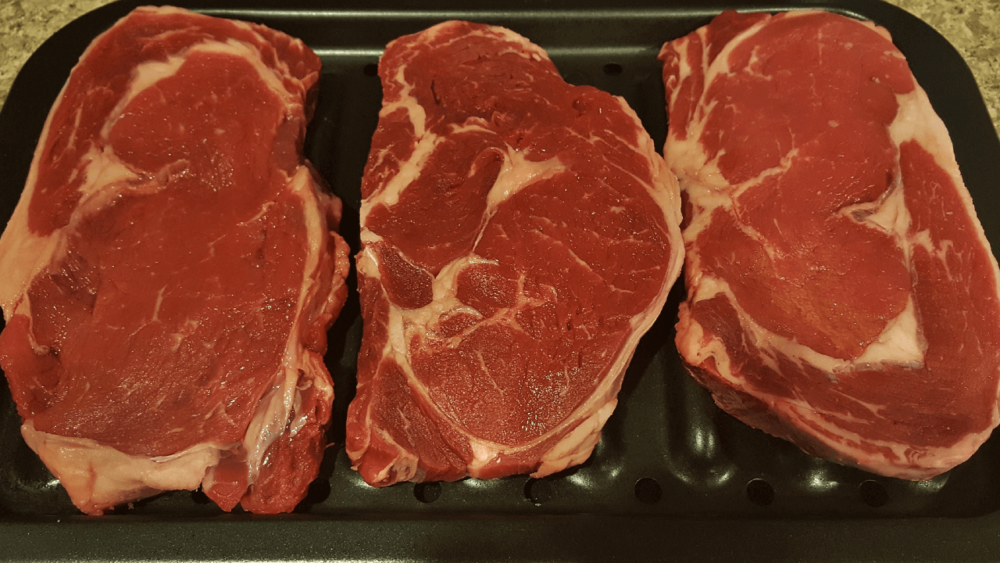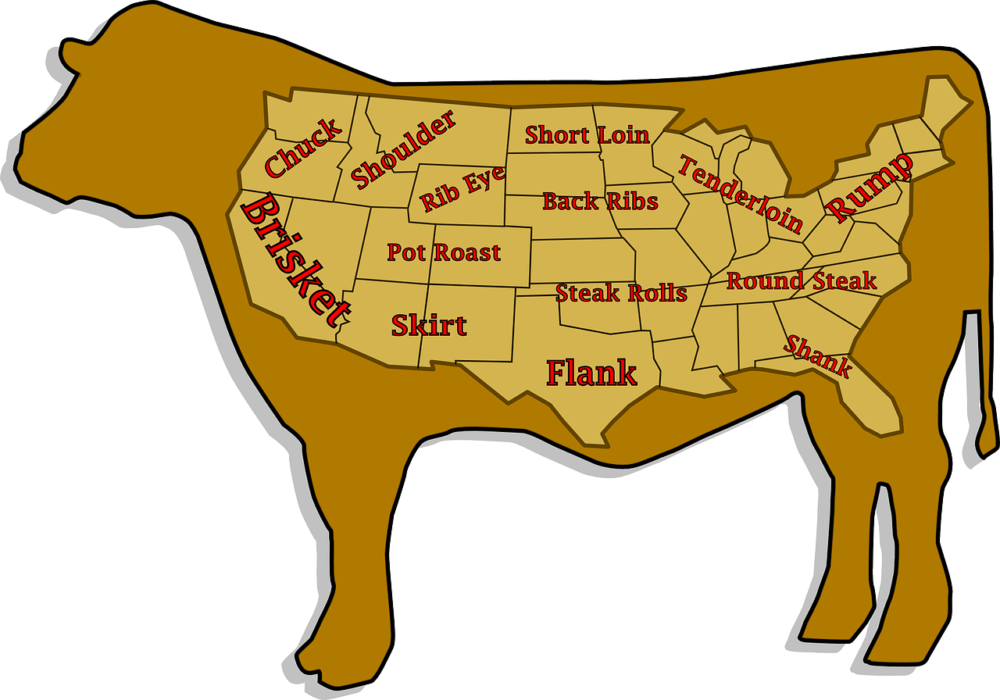There are many reasons to buy a local cow. It helps your local economy, saves the planet through a lower shipping footprint, and allows you to see how it’s raised. But, if you haven’t butchered a cow before, you may not know what questions you should ask for a smoother process.
You may be trying to decide whether to buy a cow to raise or buy an already grown cow to butcher. Usually, raising a cow isn’t as economical as buying a cow to butcher unless you already have the infrastructure in place for cattle.
Should I Buy a Quarter, Half, or Whole Beef Cow?
When I purchased a cow to slaughter, I didn’t know how much my family would eat. How many pounds is a half cow? And how does that translate to a family’s needs? I’m going to cover how you can figure out how much beef your family eats a year.
Track your family’s beef consumption for a month to get an average.
| ___?___ | My family usually eats _____________meals per week with 1 Lb of beef |
| X | Multiply by 52 weeks in a year |
| = | My family eats _________Lbs of beef a year |
According to the USDA, the average person eats 55 pounds of beef a year.
- A family of four would average 220 pounds of beef per year.
What’s the Final Amount (Take-Home Weight) of Beef From a Cow?
How much meat do you get from a butchered cow? The take-home weight (pounds) of beef per cow varies according to the steer’s cuts, size, and age. Additionally, if it was grass-finished or grain-finished will make a difference.
On average, a whole cow 1200 lb steer will yield 450-540 lbs of finished meat. A half cow will yield 225-270 lbs of processed meat. A quarter cow will yield 112-135 lbs of meat. The take-home weight is usually between 35%-45% of the live weight of the steer. This also depends on how many bone-in cuts you choose.
How Many Pounds of Beef Does My Family Eat?
| # of People in a Family | # of Pounds of Beef Eaten Per Year (On Average) | What Size of Cow Should You buy? |
| 2 Person Family | 110 lbs | Quarter Cow |
| 4 Person Family | 220 lbs | Half Cow |
| 5 Person Family | 275 lbs | Half Cow |
| 6 Person Family | 330 lbs | Three-Quarters Cow |
| 8 Person Family | 440 lbs | Whole Cow |
How Much Per Pound Will I Pay?
Depending on the farmer, you’ll pay two different ways. Some farmers calculate the butcher fees into the total cost and give you a total cost. Others sell you the cow, and then you have to pay the butcher separately.
The total cost per pound of beef varies from day to day in the beef industry. It will make a difference when you purchase your cow, but you won’t see as many fluctuations in price as at the big auctions.
The price also varies by the part of the country where you are and the availability of farmers who are willing to sell you a beef cow. You’ll want to plan on paying between $1.60 and $4.00 per pound. If you want a grass-finished steer, it’ll be $6.00-$8.00 a pound.
Once you find your cow, ask the farmer if the butcher fees are included or if you need to pay the butcher separately. You won’t have an exact price per pound until you bring your beef home.
Can I Choose My Cuts of Beef?
Some processing plants butcher for specific cuts, but most will allow you to choose your preferred cuts of beef. This means that you can ask for the cuts your family enjoys the most.
Cuts of Meat From a Whole Cow:
A whole cow will only yield a certain amount of steaks and other cuts. Since each part of the cow produces specific cuts, it’s important to know your choices. The approximate yield for a whole cow:
- 180 lbs of ground beef
- 76 lbs of roasts and steaks
- 81 lbs of chuck roasts and steaks
- 67 lbs rib and sirloin steaks
- 45 pounds of other cuts: brisket, flank, short rib, skirt steak, etc
- Soup bones
You may not know what skirt steak is, but it’s a tender, stringy part of the cow that’s up against the ribs by the flank. It’s perfect for carne asada and fajita meat.
Tips When Ordering Your Beef
- Give a weight range for your roasts
- Boneless cuts often have an upcharge
- Boneless cuts reduce the amount of meat you take home as it’s lost in the cutting process.
- Standard hanging to age is 10-14 days.
How Does the Butcher Package the Beef?
Butchers package beef in one of two primary methods. Some butchers package with butcher paper and wrap each cut. Others vacuum seal beef. The type of packaging affects the shelf life of the beef.
Vacuum Packaged
Vacuum sealed can cost a little more but lasts longer in the freezer than butcher paper-wrapped meat. Its easier to puncture vacuum packages as they are moved around in the freezer. That’s because the plastic is so tight to the meat.
Vacuum sealed beef will last a minimum of 12 months in the freezer if kept frozen.
Butcher Paper Wrapped
Butcher paper-wrapped beef is usually cheaper to process. It lasts 9-12 months in the freezer if taken care of and kept at a constant freeze. Paper wrapped doesn’t puncture as easily.
Both are popular and standard options. Many processors offer either option.
Are the Cows Born and Raised on Your Farm?
Some farmers purchase calves and raise them for sale. Other farmers buy yearlings and resell them to the public. Finding out if they have raised the steer themselves gives you a good idea of the care of the cow. Only the farmer knows the environment of the raised calf. A reseller won’t have a clear idea of the care the cow has gotten.
This is an essential question if you want a grass-finished steer. You’ll want to make sure the farmer knows the entire history of the cow.
How Old is the Steer?
The age of the steer can make a difference in the tenderness and texture of the meat. The standard age to butcher steers is around 1 year old. 2-3 years is the standard age for grass-finished steers.
As steers age, their muscles become a little tougher. This is why grass-finished beef can sometimes have a slightly different texture than grain-finished beef. This makes grain-finished steers older at butcher.
Yet, most people don’t notice a substantial difference and others prefer the taste of grass-finished better.
But, if you find that the cow for sale is several years old, it may be past its prime. Older cows are often culled and butchered when they experience breeding or health issues. Farmers only butcher bulls when they have issues breeding cows.
Even culled cattle meat is still tastier than the beef you buy at the store. It’s fresher. One year, we ate beef from a bull that had broken its leg and required culling. It was rich in taste and iron.
If you are buying older cattle to butcher, then it’s important that you understand that and get a fair price for the older cattle.
Is the Cow Grass-Finished or Grain Finished?
Grass-fed is a marketing term as all cows are grass-fed. The key is finishing. If you want a cow that’s had grass its entire life, you want grass-finished. Grass-finished cows take longer to grow and fatten than grain-finished. According to recent nutritional studies, grass-finished cows are nutritionally the same as grain-finished.
Where Will the Beef be Processed?
Butchers can be state-certified or USDA certified. State certification is fine as long as you are getting your beef processed in your home state. State certifications are stringent, and there isn’t any risk in butchering at a state-certified facility.
USDA oversees beef that crosses state lines. If you are getting the cow butchered in another state, you’ll need a USDA facility.
How Many Direct Sales Does the Farmer Do Each Year?
This question doesn’t have a right or wrong answer, but it will give you an idea of the farmer’s experience. Larger cattle producers often sell their cows by the semi-truck to feedlots. If they have a few extra cattle, they may sell them directly to consumers. Other farmers specialize in direct sales.
How Do You Accept Payment and Deliver?
You’ll want to find out how you can pay the farmer. Farmers aren’t retail businesses and may require a cashier’s check or cash for their cow. Others may accept a check but require it clear before the cow is released. Most farmers will require a deposit at the beginning of the season to reserve the steer for you.
Farmers have to reserve dates with the butcher six months to a year in advance. So they need to make sure that you’ll carry through in buying the cow.
You’ll also want to know if you will need to pick up the meat from the processor or if the farmer will pick it up for you. If you need to be available on a particular day, you’ll need to know ahead of time.
Recommended Cattle Supplies (And Dairy Supplies)
This list contains affiliate products. Affiliate products do not cost more but helps to support BestFarmAnimals and our goal to provide farm animal owners with accurate and helpful information.
This shelter is pretty easy to put together and it shelters a good number of cows. It’s sturdy and can withstand our high winds and heavy snows. And it’s cheaper than a barn and easier to build.
Colostrum is critical for calves. If you aren’t able to get some from your cows, this is a quality supplemental colostrum.
Probiotic for cattle with digestion issues in a oral tube. It works for other ruminants and is safe for goats, but is formulated especially for cattle.
A halter to lead Bessie around. This show halter also works for kids showing for 4H.
All Stock Feed is on Amazon, but you’ll pay less if you find it at your local feed store. It’s a great feed for cattle.
Electrical rope for your fencing. This keeps cattle in, but goats, alas- not so well.
Dairy Cow Recommended Supplies
Disposable towels or wet wipes are the first step in cleaning the udders.
Teat Dip and a dip cup are essential for keeping your milk clean. It lasts a while. Mine usually lasts a year to a year and a half.
I use a stainless steel bucket when I milk because it’s easy to clean and carry. These are my preferred milk filters and I use them for cow and goat milk.
This large jar funnel stays much more stable than regular funnels and can handle larger milk volumes.
I like this grain feeder while milking and use this size for the cows and goats being milked.
Balm ointment for sore udders. This cream is popular for people but formulated and created for cows’ udders.
Mastitis Test detects mastitis.




